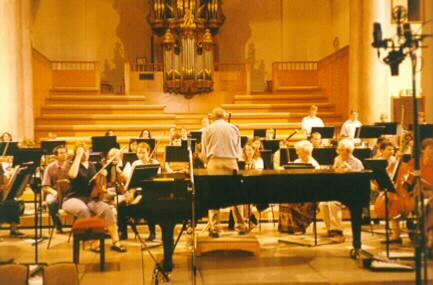Multi Microphone recordings
This method creates a montage of sound in approximately the layout of the ensemble, but by artificial means. This involves the use of multiple microphones (up to 40 or more) often used with multi track recorders, positioned very close to all the various sections of the ensemble (to try and minimise overspilling into another section covered by another microphone) or even individual instruments that the engineer wants to control. We think that the musicians are the ones who should be controlling their instruments! The outputs of all these microphones are routed into a mixer. This can have 48 or more channels that can be mixed together to produce a smorgasbord of sound. The producer and engineer decide what the sound should be like and the engineer alters the level and perhaps the frequency response of each microphone at the mixer to get that sound. Artificial reverberation is usually added because 30 plus mics placed very close to instruments cannot capture very much of the sonic signature of the venue because they are placed very close to the instruments. Another method is to put yet more mics out, but this time away from the musicians, in the body of the venue. The outputs of these 'air' mics are then mixed in with the rest. Thus the balance is taken entirely out of the musician's hands and put into the hands of the producer and engineer.
Somebody once described the process as being like buying a brand new car, gleaming from the showroom, driving it straight around to the crusher and having it crushed into a block. You then try to re-assemble the car from that block of twisted metal. What's the point when you could have just got in and driven it in the first place? You will never be able to re-assemble it to be as good as (never mind better than) the moment y ou drove it out of the showroom, or if you could, it would take a long time and cost an inordinate amount of money.
ou drove it out of the showroom, or if you could, it would take a long time and cost an inordinate amount of money.
Some engineers use what they consider to be the middle ground between what they consider to be 'extremes'. This still involves using multiple microphones and a mixer, but not so many as a multi-microphone 'extremist' would use. Others claim to use the "minimum necessary", which in practice often turns out to be 10 or more and yet more pay lip service to the idea, but claim that it's impractical. The most common reason given is that it takes too long to set up a single pair when time is so short on session. How can it take longer to put up a single pair than 20 separate mics?


 ou drove it out of the showroom, or if you could, it would take a long time and cost an inordinate amount of money.
ou drove it out of the showroom, or if you could, it would take a long time and cost an inordinate amount of money.